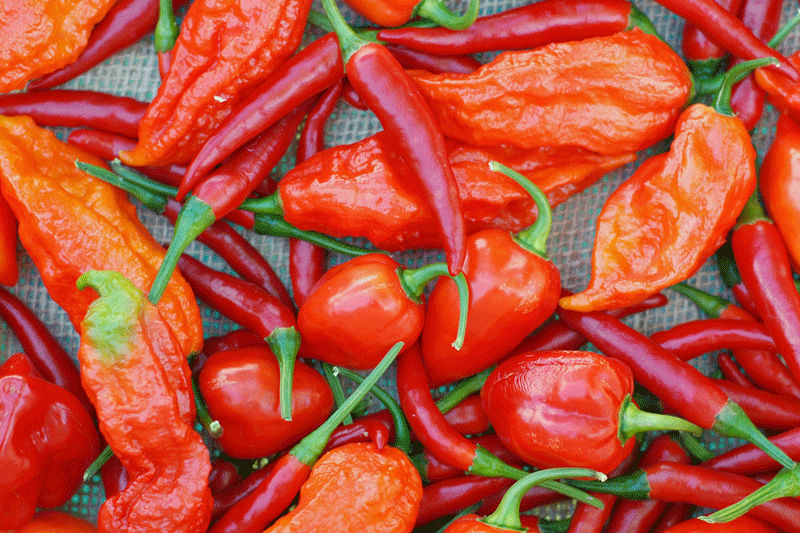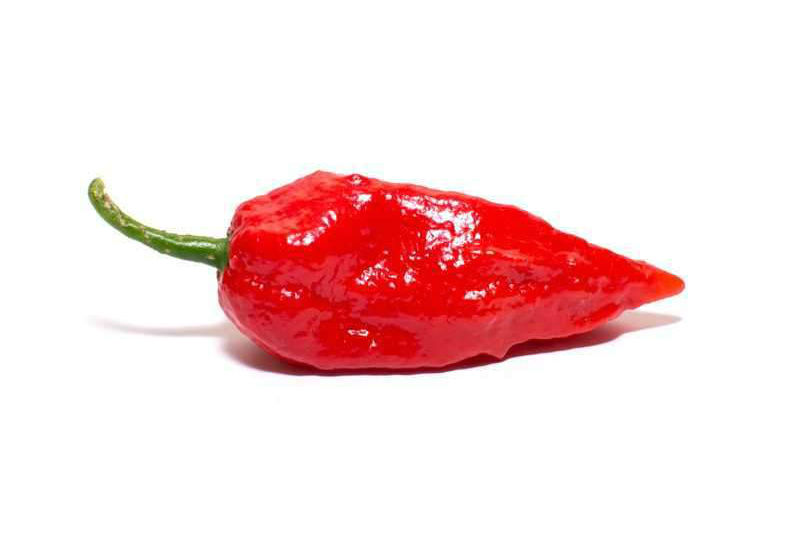Mexico has given many pleasing gifts to the world. High on that list, in my opinion, is the chili pepper. Peppers are a versatile fruit, particularly when you recognize how few species we actually eat. A single species, Capsicum annuum, is responsible for bell peppers (red, yellow, green, and orange), poblano, jalapeno, paprika, pimento, and cayenne, among others. Capsicum chinense gives us the hottest peppers, including the habanero, naga, and Scotch bonnet.

But enough with the botany. What about the spice? What is it that makes hot peppers hot? Is the heat in the seeds or the flesh? How do they measure hotness? Can you burn yourself on a pepper? What should you drink to soothe a pepper-burned mouth? Are hot peppers addictive? What good does the spice do for the plant? Admit it, you’re much more interested in those questions than whether peppers are part of the nightshade family (they are).
Capsaicin substance
So let’s talk a bit about capsaicin, the secret ingredient that put the hot in hot pepper. Actually there are a couple of other closely related versions, collectively called ‘capsaicinoids’ but they are similar enough that we can ignore them. Capsaicin is a colorless and odorless waxy solid. It may be tasteless as well, if you want to get technical about it, but I freely admit that your tongue may beg to differ on that one. The sensation of capsaicin on your tongue is sufficiently overwhelming that the question of whether it actually ‘tastes’ like anything is perhaps a moot point. Because capsaicin is hot. Really hot. Really, really hot. On the Scoville scale (more on this later), pure capsaicin scores a 16,000,000, against around 4,000 for a jalapeno pepper.
You can’t burn yourself with a hot pepper
I haven’t been able to discover any deaths confirmed to be due to capsaicin ingestion or inhalation although it is said to be deadly in sufficient doses. On the other hand, I can vouch for the fact that overexposure to the stuff can at least make you wish you were dead for a little while. Capsaicin may be the hottest stuff around, but it isn’t actually hot in any physical sense. You can’t burn yourself with a hot pepper. However, it can make you feel like you’ve burned yourself, and your confused skin may react as if it has been burned. Capsaicin activates something called TRPV1 in sensory nerve cells. TRPV1 is protein that helps the body figure out when it is touching something hot or strongly acidic. Heat and acid really can burn you, causing direct damage to all kinds of human cells. Capsaicin can’t, but since it causes the same effect to TRPV1, your body can’t readily tell the difference. The sensation will continue as long as the capsaicin is present, and as anyone who has mistakenly bitten into a particularly hot pepper will tell you, it can stick around for quite a while. Drinking water will not help, since capsaicin is more or less completely insoluble in cold water. It is more soluble in benzene, formaldehyde and alcohol, but of the three, I can really only recommend alcohol as a palliative. Milk can also help to some extent for the younger victims of chili overdose, but since it’s the fat in the milk that helps float the heat away, I’d stay away from skim.
Chili peppers seeds
Contrary to popular belief, it isn’t the chili seeds that make the pepper hot. The placental material surrounding the seeds is another matter however, and it is this tissue that contains the highest concentration of capsaicin. From the plant’s point of view, this makes perfect sense. It is thought that capsaicin evolved as a protective measure for the plants, not so much from human consumption as fungal infection. Capsaicin is a very effect antifungal agent, and plants that suffer particular high rates of insect attacks (the fungus attacks through the holes left by insects munching on the peppers) seem to be generally hotter than other members of the same species. Insects are not deterred by the capsaicin, since they lack the TRPV1 receptor which makes the stuff feel hot. Birds also lack the appropriate receptor, and will happily munch down the hottest habanero without so much as a cough. This turns out fine for the pepper as well, since the birds’ digestive system doesn’t harm the seeds and they are therefore an excellent dispersal mechanism for the plants. Your dog, on the other hand, does have the appropriate receptors, so please don’t feed chilis to the dog.
The heat in hot peppers
If you do feed peppers to the dog, one thing you probably don’t have to worry about is it becoming addicted to the spice. The heat in hot peppers does have at least one thing in common with many addictive substances-over time it takes more to have the same effect. Continued exposure to capsaicin will desensitize the nerves to a certain extent, helping explain how some of us chow down happily on peppers that make others’ eyes water just to think about. While capsaicin is not thought to be addictive in a physical sense, ingestion does provide an endorphin rush associated with the ‘pain’ of the spice. So like bungee jumping or roller coasters, peppers may be psychologically addictive in some cases.
The hottest pepper in the world
Spiciness seems like too subjective a sensation to put on a quantitative scale, especially one that goes up to 16 million. But science will find a way, and in 1912, Wilbur Scoville invented a test to determine ‘hotness’. In the Scoville organoleptic test, the hot substance is diluted in a sugar/water mixture until a panel of tasters cannot detect the heat. A bell pepper, which contains no capsaicin, scores a zero, whereas a habanero scores around 200,000, which means that you need to dilute the habanero extract by a factor of 200,000 times in order for the heat to entirely dissipate. The hottest pepper in the world is the Naga Jolokia (aka King Cobra Chili) native to northern India, which has a Scoville score of around one million.

‘Native’ is a slightly misleading term, however, since the chili pepper is a relative newcomer to Asia, arriving sometime in the 16th century. The original home to all chili peppers is Latin America-unlike the unrelated ‘true’ peppers (like black pepper), which are found in tropical and subtropical forests around the globe.
The use of chili peppers
The use of chili peppers in cooking is particularly common in tropical areas. While you could chalk that up to the fact that most chiles grow best in tropical climates, other theories have been put forward, notably that the heat served to mask the taste of meat that was going bad in the warm weather, or more hygienically, that the anti-fungal properties of capsaicin stopped the food from going bad in the first place. I prefer to think it’s the latter, but I admit that if I was going to eat rotten meat, a little spice couldn’t hurt. People have been eating chili peppers for at least the last 7500 years, but we’re still learning new uses for the things. Ointments containing capsaicin are now being used to relieve the pain of shingles and other kinds of neuropathy, as well as arthritis. It is thought that by overstimulating the nerves, the ointment stops their ability to register pain for a while. Sounds a bit bonkers, I know, but it apparently works. Capsaicin has even been shown to kill certain types of cancer cells, including prostate and leukemia. Personally, I’d be a little leery of capsaicin as chemotherapy, since in addition to the vomiting, headache, and possible convulsions which are common to all too many chemotherapy treatments, large doses of capsaicin are also known to cause burning diarrhea.
Maybe regular milk enemas could reduce the problem to a manageable level, but I’m not volunteering for that particular study. Do you?


